Travel
ITALY (2): VENICE
Bride and Mistress of the Sea
”So he again set eyes on the most astounding landing, that blinding composition of fantastic architecture, which the Republic has to offer the awestruck looks of the approaching seafarer: the light grandeur of the Palace and the Bridge of Sighs, the columns topped with the lion and the saint close to the shore, the flauntingly projecting flank of St Mark’s, the view of St Mark’s Clock, and thus contemplating he thought that arriving in Venice from the train station was like entering a palace through the servants’ entrance and that one should always, like himself, travel across the ocean to the most improbable of cities.” (Tomas Man ”Death in Venice”)
Text and photographs: Mišo Vujović
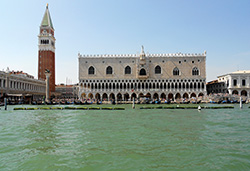 It is a curious labyrinth of history, crisscrossed by cobblestone alleys surrounded by water streets connected by stone bridges, picturesque, with mixed architecture of East and West. Ancient Greece and Byzantine, Renaissance and Baroque. It is adorned by luxurious facades with flower arrangements, occasional dilapidated buildings with sadly closed shutters below which there is a stretch of overfilled shops with clothes and souvenirs, little restaurants, bistros and pizzerias, textile and shoe shops, as well as vendors of the inevitable masks – symbols of the Venice Carnival. Murmur of the endless lines of curious visitors of the biggest pedestrian city in the world is occasionally interrupted by a sharp noise of church bells and ship sirens from a vaporetto (a boat) which sails along the main water avenue, Canal Grande, which divides Venice in two parts with three districts in each. In the northern part there are districts of Canareggio, Castello and San Marco, in the southern part – San Polo, Dorsoduro and Santa Croce. Along the Canal Grande, on both sides, there are dozens of beautiful, richly decorated palaces, symbols of power of formerly the largest trade and maritime power. Hagia Sophia is certainly one of the most representative ones. It is a curious labyrinth of history, crisscrossed by cobblestone alleys surrounded by water streets connected by stone bridges, picturesque, with mixed architecture of East and West. Ancient Greece and Byzantine, Renaissance and Baroque. It is adorned by luxurious facades with flower arrangements, occasional dilapidated buildings with sadly closed shutters below which there is a stretch of overfilled shops with clothes and souvenirs, little restaurants, bistros and pizzerias, textile and shoe shops, as well as vendors of the inevitable masks – symbols of the Venice Carnival. Murmur of the endless lines of curious visitors of the biggest pedestrian city in the world is occasionally interrupted by a sharp noise of church bells and ship sirens from a vaporetto (a boat) which sails along the main water avenue, Canal Grande, which divides Venice in two parts with three districts in each. In the northern part there are districts of Canareggio, Castello and San Marco, in the southern part – San Polo, Dorsoduro and Santa Croce. Along the Canal Grande, on both sides, there are dozens of beautiful, richly decorated palaces, symbols of power of formerly the largest trade and maritime power. Hagia Sophia is certainly one of the most representative ones.
IN THE CHARIOT OF CONSTANTINOPLE
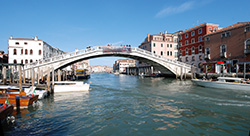 The vast anthill of tourists haunts daily this town, grown in the shallow waters of the Venetian lagoon, in which everything is available, with clearly defined Phoenician rules with a wide range of prices, from the gondola ride, service in restaurants, shopping in stores, to the parking lot, which is certainly the most profitable business at Piazza Roma and Trocento, parts of the town that can be reached by car, and where there are parking lots with daily parking fares regardless of whether you are planning to stay only for a few hours or the entire day. Although there are not many road signs, on smaller squares that are called campo, or ”fields”, there are signs pointing toward the central square – Piazza San Marco, where there is a monumental basilica of St. Mark where the relics of Saint Mark are kept, with whom the luxurious Doge's Palace is associated, and nearby there are Rialto Bridge, the Bridge of Sighs and the beautiful church of Santa Maria della Salute. The vast anthill of tourists haunts daily this town, grown in the shallow waters of the Venetian lagoon, in which everything is available, with clearly defined Phoenician rules with a wide range of prices, from the gondola ride, service in restaurants, shopping in stores, to the parking lot, which is certainly the most profitable business at Piazza Roma and Trocento, parts of the town that can be reached by car, and where there are parking lots with daily parking fares regardless of whether you are planning to stay only for a few hours or the entire day. Although there are not many road signs, on smaller squares that are called campo, or ”fields”, there are signs pointing toward the central square – Piazza San Marco, where there is a monumental basilica of St. Mark where the relics of Saint Mark are kept, with whom the luxurious Doge's Palace is associated, and nearby there are Rialto Bridge, the Bridge of Sighs and the beautiful church of Santa Maria della Salute.
 St. Mark's Square, for many one of the most beautiful squares of the world, can be reached by sea from the Piazzeta, and besides a church with the same name, there are the Lodeta and Sanson library there and the Doge's Palace, the seat of the masters of Venetian Republic. St. Mark's Square, for many one of the most beautiful squares of the world, can be reached by sea from the Piazzeta, and besides a church with the same name, there are the Lodeta and Sanson library there and the Doge's Palace, the seat of the masters of Venetian Republic.
The luxurious and expensive restaurants on the Piazza cherish the memories of Goethe, Wagner, Werner, Mozart, Windsor, the Agnellis, the Kennedys, Liz Taylor, Peter Justinov...
St Mark's Basilica, from the tower of which there is a wonderful view of the whole of Venice, was built in different styles ”collected” in military campaigns, and decorated with the booty from crusader plunders, mostly the treasure of Byzantium, those few that were saved by their beauty not to be melted down into gold coins. 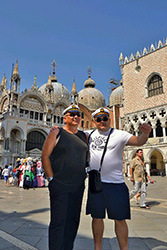 One of these relics is Four Bronze Horses, from the Hippodrome of Constantinople, now located on the first terrace of the Basilica. Horses were, according to chronicles, brought to Constantinople from the Athenian Acropolis to decorate the huge Hippodrome of Constantinople with 100,000 seats. The emperor Justinian lost his head under them, in a race at the time of the Nika Riots. Bronze Quadriga was delivered to Venice after the crusaders looted Constantinople, by order of the blind Doge Enrico Dondola. Six hundred years later, they caught Napoleon’s eye, the new master of Venice, who moved them to Paris, where he raises the Arc de Triomphe on the arch of which he mounted the Byzantine chariot with himself as the coachman. After Napoleon's defeat at the Battle of Waterloo, the great Russian emperor, Alexander I Romanov, during the victory procession under the Arc de Triomphe, ordered the bronze chariots to be returned to Venice. One of these relics is Four Bronze Horses, from the Hippodrome of Constantinople, now located on the first terrace of the Basilica. Horses were, according to chronicles, brought to Constantinople from the Athenian Acropolis to decorate the huge Hippodrome of Constantinople with 100,000 seats. The emperor Justinian lost his head under them, in a race at the time of the Nika Riots. Bronze Quadriga was delivered to Venice after the crusaders looted Constantinople, by order of the blind Doge Enrico Dondola. Six hundred years later, they caught Napoleon’s eye, the new master of Venice, who moved them to Paris, where he raises the Arc de Triomphe on the arch of which he mounted the Byzantine chariot with himself as the coachman. After Napoleon's defeat at the Battle of Waterloo, the great Russian emperor, Alexander I Romanov, during the victory procession under the Arc de Triomphe, ordered the bronze chariots to be returned to Venice.
THE QUEEN OF THE ADRIATIC SEA
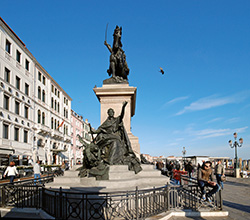 Its name symbolizes nobility, and she was not by accident called the bride of the sea, Serenissima, Queen of the Adriatic, city of bridges... Due to its turbulent and glorious past, it has become a symbol of beauty, power and luxury. Names of towns on the water are named after it: Amsterdam – ”West Venice”, St. Petersburg - ”Northern Venice”, New Orleans - ”American Venice”. Its name symbolizes nobility, and she was not by accident called the bride of the sea, Serenissima, Queen of the Adriatic, city of bridges... Due to its turbulent and glorious past, it has become a symbol of beauty, power and luxury. Names of towns on the water are named after it: Amsterdam – ”West Venice”, St. Petersburg - ”Northern Venice”, New Orleans - ”American Venice”.
Its founders, hiding in marshy lagoons during the invasion of the Huns, could not have known that their refuge would in only a few centuries grow into a trading capital and the largest port in the world. The rise of Venice begins in mid-ninth century through establishment of bishoprics and transfer of the relics of St. Mark from Alexandria. From the ninth through the twelfth century, Venice is experiencing cultural and economic prosperity, the Church of St. Mark was built, the old Doge's Palace, the city arsenal, channels are built, islan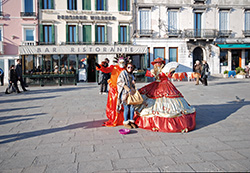 d embanked. From the thirteenth to the seventeenth century it was known as the capital of art. powerful economy has supported the arts of all styles. The interior and exterior of many buildings the monumentality and artistic decoration of which still speak of the flourishing and the power of an era, were embellished by sculptors, painters, ceramists, artists who worked with glass and wood. The flourishing of architecture and urbanism in the early sixteenth century was initiated by doge Andrea Gritti, who, with the idea to build a new Rome, and after devastation of Rome in 1527, gives shelter to exiled artists including Sansovino and San Michele, who ruled the Venetian architecture for more than 40 years. Sansovino restored basilica and bell tower of St. Mark, built the Mint, d embanked. From the thirteenth to the seventeenth century it was known as the capital of art. powerful economy has supported the arts of all styles. The interior and exterior of many buildings the monumentality and artistic decoration of which still speak of the flourishing and the power of an era, were embellished by sculptors, painters, ceramists, artists who worked with glass and wood. The flourishing of architecture and urbanism in the early sixteenth century was initiated by doge Andrea Gritti, who, with the idea to build a new Rome, and after devastation of Rome in 1527, gives shelter to exiled artists including Sansovino and San Michele, who ruled the Venetian architecture for more than 40 years. Sansovino restored basilica and bell tower of St. Mark, built the Mint,  completed the Procuratura, while San Michele built, among other things, two magnificent buildings – luxurious Grimani Castle on the Canal Grande and magnificent Palazzo Corner. Their successor, the city architect Palladio, built the church of St. Giorgio Maggiore and Church of the Savior. Venetian painting is mostly influenced by the unequaled Titian, Lotto, Giordano and Veronese... completed the Procuratura, while San Michele built, among other things, two magnificent buildings – luxurious Grimani Castle on the Canal Grande and magnificent Palazzo Corner. Their successor, the city architect Palladio, built the church of St. Giorgio Maggiore and Church of the Savior. Venetian painting is mostly influenced by the unequaled Titian, Lotto, Giordano and Veronese...
It may be useful to look at the time when the capital of the Republic of Venice in the fifteenth century was one of the most economically powerful countries in the world. Venetian Doge, Tomasetto Maccinigo, built in 1423 a dazzling balance of his empire, with a population of about 100,000, and a extensive trade acro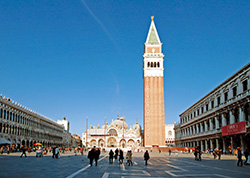 ss the globe. In boats and ships, the doge said, there are 10 million ducats, with annualrevenue of 4 million ducats. Merchant fleet consists of over 6,000 small and large boats and sailboats, and it employs 36,000 sailors, while the shipbuilding industry employed about 6,000 shipbuilders andcarpenters. In the sameperiod the ships between 10,000 and 12,000 tons of cargo per year, which is the best illustration of the economic power of the Venetian Republic, whose ruler, after the emperor and the pope, was considered the third man in the world in terms of power and influence. At that time, trading postulates used to be written on panels along Venetian canals, with the following content: ”So that trade laws are fair, measurementcorrect, and the business of merchants controlled.” ss the globe. In boats and ships, the doge said, there are 10 million ducats, with annualrevenue of 4 million ducats. Merchant fleet consists of over 6,000 small and large boats and sailboats, and it employs 36,000 sailors, while the shipbuilding industry employed about 6,000 shipbuilders andcarpenters. In the sameperiod the ships between 10,000 and 12,000 tons of cargo per year, which is the best illustration of the economic power of the Venetian Republic, whose ruler, after the emperor and the pope, was considered the third man in the world in terms of power and influence. At that time, trading postulates used to be written on panels along Venetian canals, with the following content: ”So that trade laws are fair, measurementcorrect, and the business of merchants controlled.”
MANY MASKS, TWO WEDDINGS AND IMPORTANT LESSONS
 Despite the fall of the Venetian Republic at the end of the eighteenth century and slavery under Napoleon and the Habsburgs, through the merger with the newly established Kingdom of Italy IN 1866, Venice became the most elegant and desirable city, and probably the forerunner of tourism in Europe, and in the mid twentieth century IT became the most attractive tourist destination. The city of bridges, gondoliers, navigable streets, masks, pigeons..., was stormed the Inquisition. Saints used to live in it there, martyrs spent their earthly days, sages produced their wisdom, poets searched for their inspiration... Despite the fall of the Venetian Republic at the end of the eighteenth century and slavery under Napoleon and the Habsburgs, through the merger with the newly established Kingdom of Italy IN 1866, Venice became the most elegant and desirable city, and probably the forerunner of tourism in Europe, and in the mid twentieth century IT became the most attractive tourist destination. The city of bridges, gondoliers, navigable streets, masks, pigeons..., was stormed the Inquisition. Saints used to live in it there, martyrs spent their earthly days, sages produced their wisdom, poets searched for their inspiration...
 For centuries, Venice has been challenging adventurers, fascinating travelers, hiding illusionists, luring traders, fascinated hedonists, inspired travelers, hiding adulterers, gave sensual love to those in power... For centuries, Venice has been challenging adventurers, fascinating travelers, hiding illusionists, luring traders, fascinated hedonists, inspired travelers, hiding adulterers, gave sensual love to those in power...
It impressed many great people. Goethe wrote that it could not be compared with any other city, Charles Dickens that its reality surpasses the imagination of the most tumultuous dreams, and Thomas Mann called it the most amazing of towns. Venice was adored Tchaikovsky, Monteverdi and Vivaldi composed in it, Wagner took his last breath there, Stravinsky found the last resting place there, Luciano Visconti made the film Death in Venice there, based on the novel by Thomas Mann...
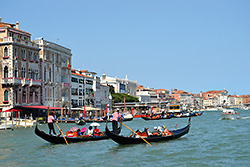 Marin Držić, the father of Dundo Maroje, one of 25 Venetian Doges, rests in the Venetian Pantheon. We remembered it from the Wedding of Maksim Crnojević and Dušan’s Wedding, from which we have a lecture that is still important today (in the era of tourism): ”the Latins are old cheaters”. Marin Držić, the father of Dundo Maroje, one of 25 Venetian Doges, rests in the Venetian Pantheon. We remembered it from the Wedding of Maksim Crnojević and Dušan’s Wedding, from which we have a lecture that is still important today (in the era of tourism): ”the Latins are old cheaters”.
Njegoš mentions it in Gorski vijenac and in Travel to Venice, in which the bishop-poet describes his room in hotel ”Austrian Emperor”, where he stayed ill and silent. ”There are many other things that I would write, but I am prevented by the noise of big bells”, wrote the great poet with evidently poor health. Miloš Crnjanski dedicated to the master of poets his poem ”Njegoš in Venice”. Even Dositej could not resist this city, Đura Jakšić calls it ”the blue bride of the green sea”, Sava Vladislavić married in Venice the beautiful Virginia Travisan, says Jovan Dučić, and Laza Kostić in his poem ”Santa Maria Della Salute” gave the eternal poetic memorial to this town.
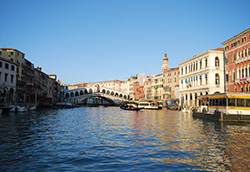 ”Is it not better to bear Beauty’s weight, hold up your arches, solid as rock, than to feed the hearths of the world’s hot hate, burning to ash the heart and its bark, than to sink like a ship, rot at a gate, like the devil’s own fir tree or oak? So much lovelier the eternal rest, o Maria della Salute, Blessed!” ”Is it not better to bear Beauty’s weight, hold up your arches, solid as rock, than to feed the hearths of the world’s hot hate, burning to ash the heart and its bark, than to sink like a ship, rot at a gate, like the devil’s own fir tree or oak? So much lovelier the eternal rest, o Maria della Salute, Blessed!”
Today, with a population of 270,000, it is the only tourist metropolis where there are no cars, and where gondolas have been transporting guests and locals for more than 1,000 years. A special experience of Venice is sailing through the Canal Grande from which you can see all the grandeur, architectural richness, diversity and uniqueness of the surroundings, but also the evident dilapidation of the buildings.
***
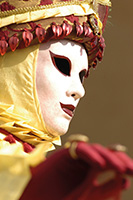 Carnival Carnival
The large open-air ball masquerade originated in the eleventh century and it is certainly the oldest event in Venice. It was written about by Goethe, but they say that it owes its fame to the great seducer Giacomo Casanova. Venetian Carnival takes place in February and it is one of the biggest in the world. Masters of the mid-fifteenth century masks officially entered the craft guild of Venice, and the Carnival itself has survived despite Napoleon's ban in the eighteenth century. The great emperor, after the conquest of the city, and fearing that the masks could be hiding spies, forbade the wearing of masks and holding the carnival.
***
Soriano
One of the trademarks of the Queen of the Adriatic, the favorite of tourists and locals, is a big tiger cat Soriano, arrived on ships from Persia and Egypt, favorite of traders and loyal guardian of shops, exterminator of rodents, and there is almost no area without one of those furry and chubby critters strutting around. In the mid 1970’a, the company, the company ”Dingo” officially protected the Venetian cats.
***
Wedding
As a sign of gratitude to the sea over which Venetian gold-bearing ships sailed, every year the doge, from a richly decorated ship in St. Nicholas Port, throws a gold ring into the sea, thus ritualistically marrying Venice and blue sea.
***
Islands, canals, bridges
It shone in splendor of ravaged treasures of the universe, endured and remained to this day the most romantic, and arguably the most beautiful city in the world. Venice is situated on 118 small islands connected with over 160 channels, 400 bridges, and it has a few hundred palaces.
|
